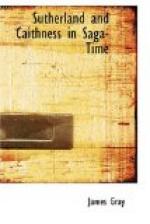When the Vikings came, they came as worshippers of Thor and Odin and the old Teutonic gods. To them the Christianity of the Pict was “a weak effeminate creed.” They, therefore, slew its followers, plundered its shrines, and drove its clergy south from Orkney, from north-east Caithness and the coasts of Sutherland, and from the seaboard of Ross and Moray, and for a century and a half Christianity was uprooted and almost wholly expelled. No jarl before Sigurd Hlodverson was a Christian, and he was baptized by force, and died fighting for Odin at Clontarf. With all “the fury of an expiring faith, its last lambent flickering flame, against a creed that seemed to contradict every article of the old belief,"[2] wherever they came, they destroyed the cult and culture of Columba, which it had taken several centuries to establish in the north and west of Alban.
When the conquerors settled in the land, they enslaved such of its inhabitants as remained among them for a time, and gave to the best coastal lands and lower valley farms the Norse names which they still bear, but they left the heads of the river valleys and the hills mainly to the Moddan family and their Pictish followers and clansmen, who held them tenaciously and extended their holdings, as the Norse became less hostile through inter-marriage, or less strong. Once settled, the Norse exerted such steady pressure on their southern Pictish neighbours in Ross and Moray, and kept them so fully occupied in war or by the constant menace of it from the north, that successive Scottish kings were in their turn left comparatively free, on their own northern frontier, from Pictish attacks, and were therefore enabled to consolidate their own kingdom in the south of Scotland and to beat the English back to the line of the Tweed. Afterwards they were able to turn their attention to the consolidation of the mainland north of the Grampians,[3] by first overcoming the Picts in Moray, and then the Norse in Cat, and establishing the feudal system and the Catholic Church.
Worshipping, as the Vikings did, amongst others, the “fair white god Baldr of golden beauty,” and accounting as base-born “hellskins” those of darker hue, it seems strange that they should so soon have taken to themselves Celtic wives. But we have seen that they came by sea and that no Norse women were allowed in Viking ships,[4] and thus it was Celtic mothers alone that perpetuated the race. They also taught the children the Gaelic tongue, and, on the mainland in all Sutherland and Caithness save the north-eastern portions of the latter, Gaelic soon became again the only spoken language.
But the language was Gaelic with a difference. As already stated, it contained, especially in connection with the sea, and ships, gear, and tackle, many old Norse words,[5] and, in the Gaelic of Sutherland, as in the English of Orkney and Shetland and of Caithness and Moray the Old Norse roots remain. Nor need we believe that every Magnus or Sweyn, or Ragnvald was a pure Norseman. For their Celtic mothers often preferred to give their children Old Norse names.




